Predicting Short-Term Habitat Shifts in Mountain Bumblebees with Maxent Modelling

Introduction
This article continues our exploration of spatial data science in ecology, focusing on the application of species distribution models (SDMs) to assess habitat suitability. In our previous article (link to the first article), we applied Maximum Entropy (Maxent) modelling to study the distribution of bumblebees across the UK. Surprisingly, our analysis revealed that overall habitat suitability for bumblebee species increased between 2018 and 2023. However, these findings only represent short-term changes, prompting deeper questions about the specific habitats gained or lost during this period.
While expanding habitats may benefit some bumblebee species, others—particularly those dependent on shrinking environments—may face significant challenges. This highlights an important consideration in ecological modelling: how study focus and species selection influences the interpretation of results.
To investigate these dynamics more closely, we shift our attention to Bombus monticola, the Mountain Bumblebee. This species inhabits cooler, high-altitude regions, making it especially vulnerable to rising temperatures and shifting ecosystems. Mountainous areas are projected to experience severe ecological impacts as the climate warms, threatening species uniquely adapted to these fragile environments.
Recent studies, such as Singh et al. (2024), paint a dire picture: by 2050, habitat suitability for mountain bumblebees of the Himalayan region could decline to less than 10% of their current range for two-thirds of species. Such alarming forecasts underline the need for urgent, proactive conservation strategies to safeguard these critical pollinators
Methods
To model habitat suitability for Bombus monticola, we utilized environmental raster layers derived from the TerraClimate dataset and processed using Google Earth Engine and R. Elevation data were sourced from the ALOS World 3D Global Digital Surface Model (DSM) dataset, ensuring high-resolution spatial coverage of the study area.
Environmental Predictors
The following environmental variables were included in the Maxent model, selected for their relevance to bumblebee ecology and habitat characteristics:
- Elevation (elev): The primary determinant of Bombus monticola’s distribution in mountainous regions.
- Slope and Hillshade: Indicators of topographic complexity and microhabitat variability.
- Palmer Drought Severity Index (PDSI): A measure of drought stress, crucial for understanding water availability.
- Precipitation Accumulation (pr): Total precipitation, critical for floral resource abundance.
- Soil Moisture (soil): Reflects water retention and availability in the habitat.
- Minimum Temperature (tmmn) and Maximum Temperature (tmmx): Key climatic factors influencing species survival and reproduction.
- Wind Speed (vs): Relevant for flight dynamics and pollination activity.
Data Visualization
The environmental predictors were compiled into raster layers, forming a spatially explicit dataset for habitat suitability modelling. Below is the raster stack for the year 2018, illustrating the spatial distribution of these predictors. These layers were used as inputs for the Maxent model to predict Bombus monticola habitat suitability.
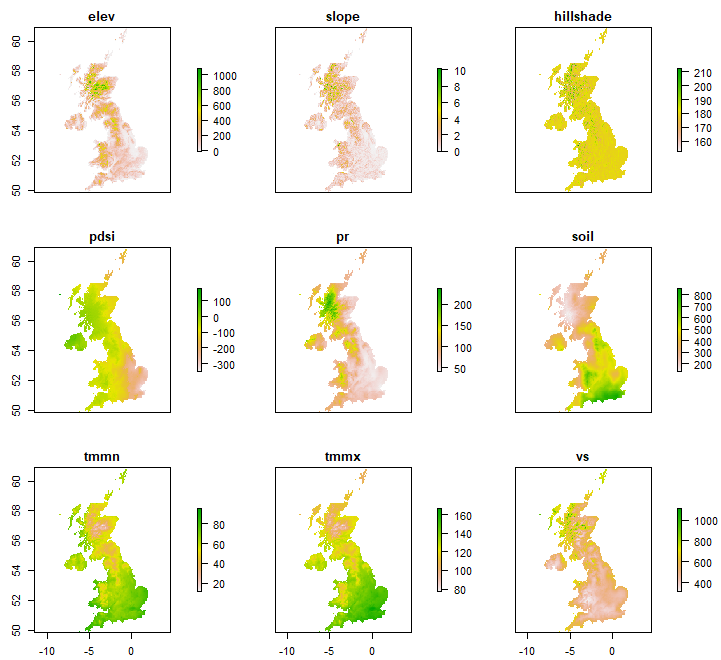
Species occurrence data
Occurrence records for Bombus monticola were obtained from the Global Biodiversity Information Facility (GBIF), a global repository of biodiversity data. The dataset was filtered to include only records of Bombus monticola within the selected time period. These occurrence points served as presence data for the Maxent model, enabling the predictions of habitat suitability.
Results and Discussion
Our analysis reveals that the total habitat suitability area for Bombus monticola, the Mountain Bumblebee, decreased over the five-year period from 2018 to 2023. While the northern regions of the UK remain amongst the most suitable habitats for this species, our findings show a significant decline in suitability within these areas over this short timeframe.
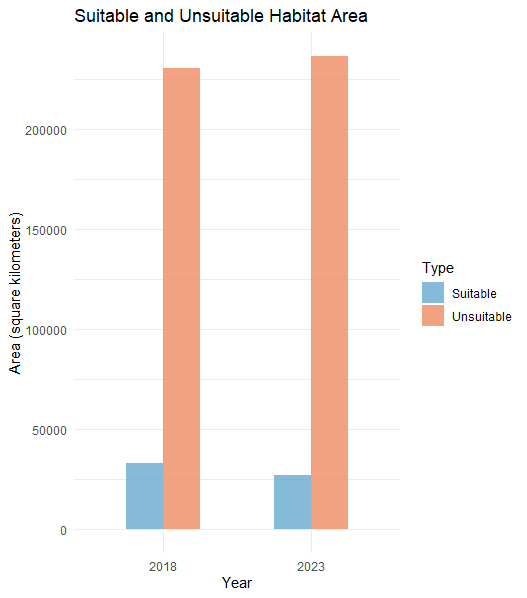
These results contrast sharply with our earlier analysis (see our previous post), where we observed an overall increase in habitat suitability for all bumblebee species combined. This discrepancy highlights an important ecological dynamic: habitat changes may favour certain species while disadvantaging others. For * B. monticola *, the observed decline underscores its vulnerability to short-term environmental changes.
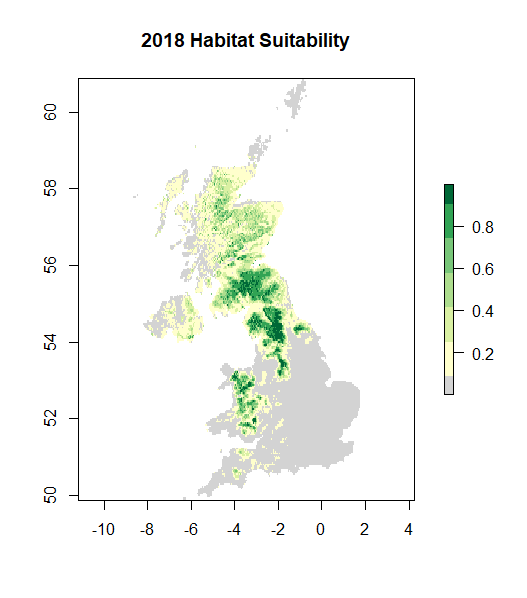
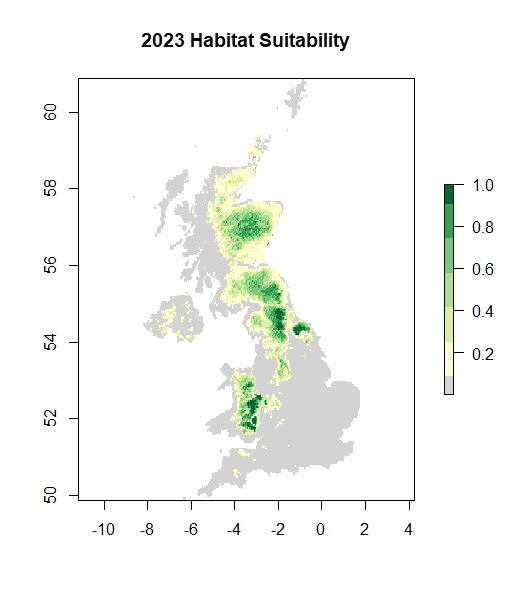
These findings also illustrate how the choice of species, scale, or focus can shape the outcomes of an ecological analysis. For instance:
- Focusing on highly vulnerable species, such as Bombus monticola , can reveal critical insights into their specific challenges and conservation needs.
- Conversely, a multi-species approach highlights broader trends but may obscure the nuanced patterns that individual species analyses can uncover. Both approaches have value depending on the research question. However, species-specific studies are crucial for identifying targeted conservation strategies for species at high risk.
The inspection of variable contributions highlights the significance of topography, soil moisture, and temperature in determining the habitat suitability for the Mountain Bumblebee, Bombus monticola. The model results from both 2018 and 2023 indicate that elevation consistently plays the most significant role, underscoring its importance in defining this species’ range within mountainous regions. However, since elevation and topography remain static over time, the observed changes in habitat suitability are likely driven by dynamic variables such as soil moisture and temperature.
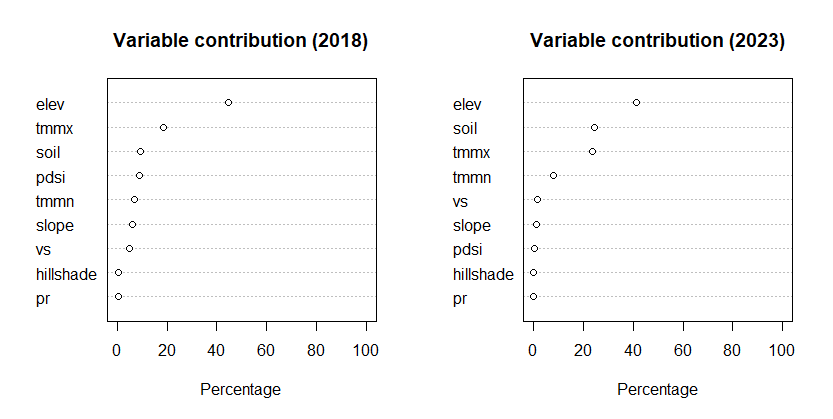
In 2018, the Maxent model identified maximum temperature (tmmx) and soil moisture as key secondary predictors, contributing substantially to habitat suitability alongside elevation. By 2023, the contributions of these variables shifted slightly, with soil moisture becoming more prominent. This change suggests that moisture availability has become increasingly critical for sustaining suitable habitats, likely due to its role in supporting vegetation and floral resources essential for bumblebees (Dai et al., 2022; Höfer et al., 2021).
Moreover, the influence of maximum temperature (tmmx) reflects the sensitivity of Bombus monticola to rising temperatures. Warmer conditions may directly affect the physiological tolerances of the species (White & Dillon, 2023) or indirectly reduce habitat suitability by altering the availability of flowering plants. The increasing dominance of these climate-sensitive variables highlights the vulnerability of mountain ecosystems to short-term environmental changes and suggests that temperature and moisture dynamics are key drivers of the observed habitat decline.
It is important to note that this study is based on a short-term analysis spanning just five years. While the results provide valuable insights into immediate changes in habitat suitability, they cannot be directly extrapolated to predict long-term trends or trajectories. However, short-term effects, such as shifts in soil moisture and temperature, can cascade into long-term consequences by influencing habitat persistence, floral resource availability, and population dynamics. Extending this analysis over a longer timescale, with finer temporal resolution, would be crucial for understanding the magnitude and persistence of these changes, as well as their broader ecological impacts.
This analysis reinforces that beyond the static influence of topography and elevation, dynamic predictors such as soil moisture and temperature play a critical role in shaping habitat suitability. These findings highlight the vulnerability of Bombus monticola to rapid environmental changes and emphasize the need for targeted conservation strategies to address climate impacts on key ecological variables. Protecting the habitats of mountain bumblebees requires urgent action, even in the face of short-term changes, as these may herald long-term challenges for the survival of this and other sensitive species.
References
Dai, W., Yang, Y., Patch, H. M., Grozinger, C. M., & Mu, J. (2022). Soil moisture affects plant–pollinator interactions in an annual flowering plant. Philosophical Transactions of the Royal Society B: Biological Sciences, 377(1853), 20210423. https://doi.org/10.1098/rstb.2021.0423
Höfer, R. J., Ayasse, M., & Kuppler, J. (2021). Bumblebee Behavior on Flowers, but Not Initial Attraction, Is Altered by Short-Term Drought Stress. Frontiers in Plant Science, 11, 564802. https://doi.org/10.3389/fpls.2020.564802
White, S. A., & Dillon, M. E. (2023). Climate warming and bumble bee declines: The need to consider sub-lethal heat, carry-over effects, and colony compensation. Frontiers in Physiology, 14, 1251235. https://doi.org/10.3389/fphys.2023.1251235
Singh, A. P. (2024). Unveiling of climate change-driven decline of suitable habitat for Himalayan bumblebees. Scientific Reports.